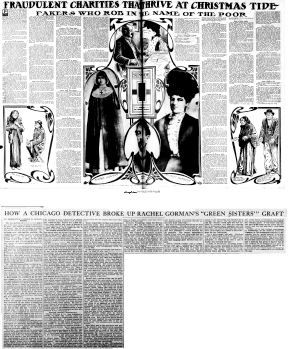|
Nurse Rachael
Around 1900, Rachael Gorman went to work as a roommate of and nurse for
William Held's Home for Epileptics. In another
decade would come the development of Phenobarbital,
but in 1900 "epilepsy" was an umbrella term used to
reference a group of conditions that included mental
illness, demonic possession, and syphilis. Held
promised to cure them all. The only thing Rachael
nursed was wallets, and she did it well, too well.
When her earnings outstripped Held's, they quarreled
and parted company. He said she drank too much and
was dishonest in her financial reports.
Rachael clones
She formed a new partnership and expanded. She hired a half dozen
assistants and trained them in the art of charity
solicitation, giving her the capacity to better
penetrate Chicago and move into other cities. Donned
in green robes patterned after those of Catholic
nurses, including a cross necklace, the "Green
Sisters," as they eventually came to be called by
law enforcement, looked and sounded like sisters of
charity. Unlike other groups of sisters,
however, Rachael and her girls were connected with
no church or religious order. Their
collections went to support themselves and their
bogus treatment facilities.
Iroquois Theater story
At the time of the Iroquois Theater fire, public exposure of Rachael's
game was a year off, so the Inter Ocean
reporter gave her the benefit of the doubt when
hearing her story the evening after the fire. It is
not likely she was anywhere near the painters'
planks over Couch Place. More probable is that she
overheard conversations about the plank crossings
while at the
Sherman House, Marshall Field's, or another of
the sites where survivors and reporters congregated
that first night. Ever a quick study, Rachael
inserted herself into the storyline, probably to
work a charity angle. The Inter Ocean
reporter may not have been sure she was lying, but
I think he and/or his editor had reservations. Based on other stories about the
plank, the reference to Rachael was brief. The Chicago Tribune
didn't bite on it, nor did
Coroner Traeger; even though Traeger made a
point of calling other plank crossers to testify, Rachael did not testify. Logistics
made it unlikely that she hung out at the windows of the
Northwestern dental department. The narrow windows were crowded with painters
trying to keep the planks anchored and she would have been in the way. It was the kind
of story embroidery added by someone who wasn't there — while working the crowd for
donations.
One of the 2003 anniversary books about the Iroquois Theater fire, Tinder Box,
picked up and repeated the reference to Rachel's heroism, missing subsequent newspaper stories
about her chicanery. Author Anthony Hatch accumulated data over many years and
were it not for his efforts there are aspects of the disaster that would not be known
but a con artist nun slipped past him.
|
 |
Staging the scene
As was
common for the time, American Chronic and
Epileptic Association also made outrageous promises
of cures, but for Rachael and her cohorts, tonic
sales and patient fees were a secondary revenue
source at best. They were props and camouflage in a
carefully engineered con that pried money from the
pocket of
William Jennings Bryan and scores of other
politicians and businessmen. She often targeted
winning bettors at racetracks and maintained a
little black book of her regular marks. Political
and trade conventions were lucrative, including the
St. Louis World's Fair in 1904. Rachael's assistants
were also assigned to trains, saloons, and
restaurants. Rachael's personal twist on the scheme
was to party with her mark, while garbed as a nun,
until he became boastful about his track win or
other financial success, then hit him up for a
donation.
Round Lake farm
After several partnership dissolutions and restructurings, Rachel went solo
and formed the Rachael Gorman Home for Epileptics.
For a time, it operated a "treatment center" at a
farm in Round Lake, IL, north of Chicago. A whopping
seven patients were sent there during its eighteen
months of operation.
Blue Island home
In 1904 she purchased a home in Blue Island to accommodate her patients and
maintained an office in downtown Chicago as an
operational hub. She needed a place for her troops
to change into their nun uniforms and receive her
instructions about travel and targets. It was a busy
time. Two of Rachael's former partners had begun to
imitate her solicitation methods, including corps of
nun-garbed solicitors. In early 1904, roughly
eighteen of them worked the Midwest, each with their
own robe color.
Shut down and exposed
In October 1904 came a tip about bogus epilepsy treatment facilities from Dr.
James A. Egan, Secretary of the Illinois State Board
of Health. The police became determined to shut down
Rachael and her imitators, raiding her office on
Wisconsin St. Enough evidence was found to move on
to her house in Blue Island. There, police
discovered she had only two patients and three
servants who put on "seizure shows" in the front
yard to dissuade curious neighbors or authorities.
She was forced to close her "hospital" and
threatened with imprisonment if she continued
charity solicitations.

Read two major Chicago newspapers in 1906 & 1907 exposing Rachael Gorman.
|
